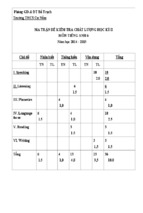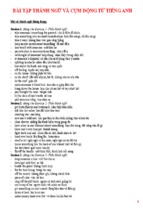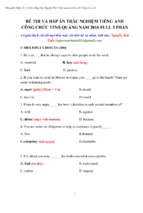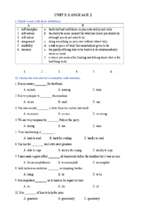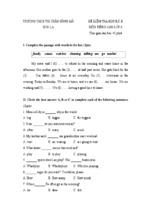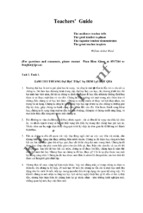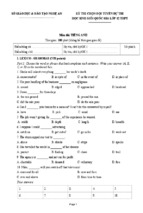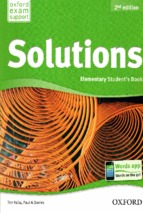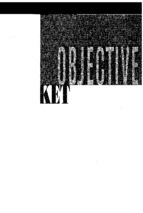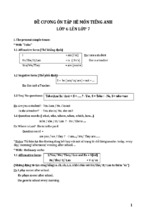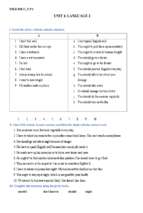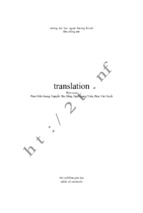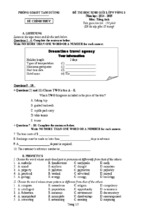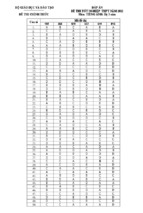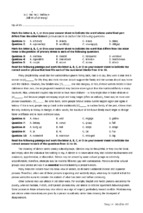visit the link to get test
Website : https://1001dethi.com/ dt 0909265875 .thầy phúc
SÁCH STARTERS :
Cụ thể : 1 bộ sách Starters 9 cuốn +audio listening
Trọn gói : 50.000Đ.
SÁCH MOVERS :
Cụ thể : 1 bộ sách Movers 9 cuốn + audio listening
Trọn gói : 50.000Đ.
SÁCH FLYERS :
Cụ thể : 1 bộ sách Flyers 9 cuốn +audio listening
Trọn gói : 50.000Đ
SÁCH KET :
Cụ thể : 1 bộ sách KET 10 cuốn +audio listening
Trọn gói : 50.000Đ
SÁCH PET :
Cụ thể : 1 bộ sách PET 8 cuốn +audio listening
Trọn gói : 40.000Đ
SÁCH Longman New Real Toeic (Trọn bộ 3 cuốn RC,LC và Full)
Trọn gói : 30.000Đ
Nguyen Thuy Mi_07.1.e3_k41
*****************************************************************************
Definition & Features of Academic writing
Introduction
Academic writing in English is linear, which means it has one central point or theme with every
part contributing to the main line of argument, without digressions or repetitions. Its objective is
to inform rather than entertain. As well as this it is in the standard written form of the language.
There are six main features of academic writing that are often discussed. Academic writing is to
some extent: complex, formal, objective, explicit, hedged, and responsible. It uses language
precisely and accurately.
I, Complexity
Written language is relatively more complex than spoken language (Biber, 1988; Biber,
Johansson, Leech, Conrad & Finegan, 1999; Chafe, 1982; Cook, 1997; Halliday,1989). Written
language has longer words, it is lexically more dense and it has a more varied vocabulary. It uses
more noun-based phrases than verb-based phrases. Written texts are shorter and the language has
more grammatical complexity, including more subordinate clauses and more passives.
Written texts are lexically dense compared to spoken language - they have proportionately more
lexical words than grammatical words. Written texts are shorter and have longer, more complex
words and phrases. They have more noun-based phrases, more nominalizations, and more lexical
variation.
Written language is grammatically more complex than spoken language. It has more subordinate
clauses, more "that/to" complement clauses, more long sequences of prepositional phrases, more
attributive adjectives and more passives than spoken language.
The following features are common in academic written texts:
Noun-based phrases, Subordinate clauses/embedding, Complement clauses, Sequences of
prepositional phrases, Participles, Passive verbs, Lexical density, Lexical complexity,
Nominalization, Attributive adjectives
1. Noun-based phrases
Formal written English uses nouns more than verbs.
Writing portfolio
**************************************************************************
3
Nguyen Thuy Mi_07.1.e3_k41
*****************************************************************************
Like all other forms of life, we human beings are the product of evolution.
Like all other forms of life, we human beings are the product of how we have evolved.
The noun "evolution" is preferred to the verb "evolve" and the "wh" clause.
Another example is:
Premack used a set of plastic chips to teach a chimpanzee named Sarah the meaning of a set of
symbols.
Premack used a set of plastic chips to teach a chimpanzee named Sarah what a set of symbols
mean.
"The meaning of the symbols" is preferred to "what the symbols mean"
Modification of noun-phrases
Written English is lexically dense - there is a higher proportion of content words
per clause. This can be done by modification of noun-phrases.
pre-modifier + noun
adjective
ed-participle
the constitutional aspects
a balanced budget, from the confused events of 19-24 August, the
ing-participle
emitted light
growing problem, one striking feature of the years 1929-31, existing
structures
noun - market forces, noun - market forces, cabinet appointments
cabinet appointments
noun + post modifier
relative clause
to-clauses
ing-clauses
ed-clauses
students who have no previous experience
the solution to the problem of inflation, the question to be debated
a brake consisting of a drum divided into twelve compartments
canoes preserved by a hard plaster, a brake consisting of a drum
prepositional phrase
divided into twelve compartments, the curve shown
we need to bring to the box a special tool with a ready-compressed
adverb (phrase)
adjective (phrase)
spring
the road back, the people outside
varieties common in India, the festival proper, something different
2. Subordinate clauses/embedding
There are several factors which help to prolong this period to perhaps three or four times that in
Writing portfolio 4
**************************************************************************
Nguyen Thuy Mi_07.1.e3_k41
*****************************************************************************
the male.
The other way in which the economic aspects of military expenditure were presented was in the
form of the public expenditure costs.
The family establishes a variety of bases for refuges which seem to be used at different times of
the year.
3. Complement clauses
that-clauses
This conforms conveniently with Maslow's (1970) claim that human
motivation is related to a hieracrchy of human needs.
It follows that if the Labour Government is to secure acceptance of its
economic package, it has to secure the support of MPs from either the
to-clauses
Liberal or the Conservative party.
Britain's apparent ability to rally Commonwealth support at Chicago seemed
of+ ing-clauses:
to the Americans to be evidence of Britain's continued world power.
The possibility of increasing dollar receipts was coupled with a belief that
Africa could be a strategic centre for British power.
4. Sequences of prepositional phrases
Sequences of prepositional phrases are common in academic English.
This article analyses the constitutional aspects behind the formation of the first and second
National Governments, examining in particular the role of the king in the formation of the two
governments.
5. Participles
Formal written English uses verbs less than spoken English. -ed and -ing participles allow
verbs to be used nominally or adjectively.
Similar temptations overcame philosophers concerned with establishing a secure base for
individual responsibility
The Egyptians regarded time as a succession of recurring phases.
Doubts as to the proper division of property at death, as well as rights between partners living
Writing portfolio
**************************************************************************
5
Nguyen Thuy Mi_07.1.e3_k41
*****************************************************************************
together, were resolved by having legal rules prescribing a formula.
It was only to be tolerated in a controlled and formalized context.
A frequent change found in proper names is syllable loss.
6. Passive verbs
In spoken English we often use a subject such as "people", "somebody", "they",
"we", or "you" even when we do not know who the agent is. In formal English,
particularly writing, we often prefer to use a passive.
Compare:
They're installing the new computer system next month.
The new computer system is being installed next month. (more formal)
7. Lexical density
Written English generally has a much denser pattern of words, it is more lexically dense. If we
define lexical density as the number of content words in a clause, then written English has a
higher lexical density than spoken English (Halliday, 1996, p. 347).
For example, the written text:
Obviously, the government is frightened of union reaction to its move to impose proper
behavior on unions.
is more lexically dense than the spoken version:
Obviously, the government is frightened how the unions will react if it tries to make them
behave properly.
8. Lexical complexity
Adding affixes to existing words (the base) to form new words is common in academic English.
Prefixes are added to the front of the base (like
of the base (active
dislike), whereas suffixes are added to the end
activate). Prefixes usually do not change the class of the base word, but
suffixes usually do change the class of the word.
Writing portfolio
**************************************************************************
6
Nguyen Thuy Mi_07.1.e3_k41
*****************************************************************************
The most common prefixes used to form new verbs in academic English are: re-, dis-, over-, un-,
mis-, out-. The most common suffixes are: -ise, -en, -ate, -(i)fy. By far the most common affix in
academic English is -ise.
EXAMPLES:
a, VERBS
verbs + prefix
verb
Prefix Meaning
Examples
re-
again or back
restructure, revisit, reappear, rebuild, refinance
dis-
reverses the meaning of the verb disappear, disallow, disarm, disconnect, discontinue
over-
too much
un-
reverses the meaning of the verb unbend, uncouple, unfasten
mis-
badly or wrongly
mislead, misinform, misidentify
out-
more or better than others
outperform, outbid
be-
make or cause
befriend, belittle
co-
together
co-exist, co-operate, co-own
de-
do the opposite of
devalue, deselect
fore-
earlier, before
foreclose, foresee
inter-
between
interact, intermix, interface
pre-
before
pre-expose, prejudge, pretest
sub-
under/below
subcontract, subdivide
trans-
across, over
transform, transcribe, transplant
under- not enough
overbook, oversleep, overwork
underfund, undersell, undervalue, underdevelop
Suffix used to form verbs with the meaning "cause to be".
Suffix Example
-ise
stabilise, characterise, symbolise, visualise, specialise
-ate
differentiate, liquidate, pollinate, duplicate, fabricate
-fy
classify, exemplify, simplify, justify
-en
awaken, fasten, shorten, moisten
b, NOUNS:
Writing portfolio
**************************************************************************
7
Nguyen Thuy Mi_07.1.e3_k41
*****************************************************************************
The most common prefixes used to form new nouns in academic English are: co- and sub-. The
most common suffixes are: -tion, -ity, -er, -ness, -ism, -ment, -ant, -ship, -age, -ery. By far the
most common noun affix in academic English is -tion.
noun+ prefix
noun
Prefix
Meaning
Examples
anti-
against
anticlimax, antidote, antithesis
auto-
self
autobiography, automobile
bi-
two
bilingualism, biculturalism, bi-metalism
co-
joint
co-founder, co-owner, co-descendant
counter- against
counter-argument, counter-example, counter-proposal
dis-
the converse of
discomfort, dislike
ex-
former
ex-chairman, ex-hunter
hyper-
extreme
hyperinflation, hypersurface
in-
the converse of
inattention, incoherence, incompatibility
in-
inside
inpatient,
inter-
between
interaction, inter-change, interference
kilo-
thousand
kilobyte
mal-
bad
malfunction, maltreatment, malnutrition
mega-
million
megabyte
mis-
wrong
misconduct, misdeed, mismanagement
mini-
small
mini-publication, mini-theory
mono-
one
monosyllable, monograph, monogamy
neo-
new
neo-colonialism, neo-impressionism
out-
separate
outbuilding,
poly-
many
polysyllable
pseudo-
false
pseudo-expert
re-
again
re-organisation, re-assessment, re-examination
semi-
half
semicircle, semi-darkness
sub-
below
subset, subdivision
super-
more than, above superset, superimposition, superpowers
Writing portfolio
**************************************************************************
8
Nguyen Thuy Mi_07.1.e3_k41
*****************************************************************************
sur-
over and above
surtax
tele-
distant
telecommunications,
tri-
three
tripartism
ultra-
beyond
ultrasound
under-
below, too little
underpayment, under-development, undergraduate
vice-
deputy
vice-president
Suffix added to a verb (V), noun (N) or adjective (A)
noun
Suffix
Meaning
Examples
-tion
action/instance of V-ing
alteration, demonstration
-ity
state or quality of being A ability, similarity, responsibility
person
-er
who
V-s advertiser,
driver
something used for V-ing computer,
silencer
person concerned with N
astronomer, geographer
-ness
state or quality of being A darkness, preparedness, consciousness
-ism
doctrine of N
Marxism, Maoism, Thatcherism
-ment
action/instance of V-ing
development, punishment, unemployment
-ant/-ent person who V-s
assistant, consultant, student
-ship
friendship, citizenship, leadership
-age
-ery/-ry
state of being N
collection
of
action/result of V
N baggage,
breakage, wastage, package
action/instance of V-ing bribery,
place of V-ing
plumage
robbery,
misery
refinery, bakery
c, ADJECTIVES:
Many adjectives are formed from a base of a different class with a suffix (e.g. -less, -ous).
Adjectives can also be formed from other adjectives, especially by the negative prefixes (un-, inand non-).
The most common suffixes are -al, -ent, -ive, -ous, -ful, -less.
Suffix added to verbs or nouns
adjective
Writing portfolio
**************************************************************************
9
Nguyen Thuy Mi_07.1.e3_k41
*****************************************************************************
Suffix Examples
-al
central, political, national, optional, professional
-ent
different, dependent, excellent
-ive
attractive, effective, imaginative, repetitive
-ous
continuous, dangerous, famous
-ful
beautiful, peaceful, careful
-less
endless, homeless, careless, thoughtless
-able
drinkable, countable, avoidable,
adjective + negative
adjective
Prefix
Examples
un-
unfortunate, uncomfortable, unjust
im-/in-/ir-/il- immature, impatient, improbable, inconvenient, irreplaceable, illegal
non-
non-fiction, non-political, non-neutral
dis-
disloyal, dissimilar, dishonest
base with both prefix and suffix
-able
-tion
-tive
-ment
-ar
uncomfortable
un-
unavoidable
unimaginative
unforgettable
mis-
re-
in-
misjudgement
misinformation
recoverable
recyclable
irreplaceable
dissemi-
mismanagement
reformulation
reproductive
incoordination
inactive
inattention
inoperative
disconnection
realignment
repayment
disappointment
semiconductive
semi-circular
9. Nominalization
Formal written English uses nouns more than verbs. For example, "judgment" rather than
"judge", "development" rather than "develop", "admiration" rather than "admire".
Writing portfolio 10
**************************************************************************
Nguyen Thuy Mi_07.1.e3_k41
*****************************************************************************
Examples
Instead of:
This information enables us to formulate precise questions.
we would write:
This information enables the formulation of precise questions.
More examples are:
There appeared to be evidence of differential treatment of children.
This is reflected in our admiration for people who have made something of their lives,
sometimes against great odds, and in our somewhat disappointed judgment of those who merely
drift through life.
All airfields in the country would be nationalized, and the government would continue with the
development of new aircraft as recommended by the Brabazon Committee.
Read the following text:
Reproduction with variation is a major characteristic of life. Without reproduction, life would
quickly come to an end. The earliest single-celled organisms reproduced by duplicating their
genetic material and then dividing in two. The two resulting daughter cells were identical to each
other and to the parent cell, except for mutations that occurred during the process of gene
duplication. Such errors, although rare, provided the raw material for biological evolution. The
combination of reproduction and errors in the duplication of genetic material results in biological
evolution, a change in the genetic composition of a population of organisms over time.
W. K. Purves, D. Sadava, G. H. Orians & H. C. Heller, Life: The science of biology, W. H.
Freeman, 2004
and compare it to:
All organisms reproduce and sometimes when they reproduce, the children vary. This is an
important characteristic of life. If organisms did nor reproduce, life would quickly come to an end.
How did the earliest single-celled organisms reproduce? They duplicated their genetic material
Writing portfolio 11
**************************************************************************
Nguyen Thuy Mi_07.1.e3_k41
*****************************************************************************
and then they divided in two. Two daughter cells resulted from this process; they were identical to
each other and to the parent cell. But sometimes as the genes duplicated, they changed or mutated.
These errors are not very common but they provide the basic material for life to evolve. So when
the genetic material duplicates, they reproduce and they make errors. As a result, there is a change
in what the genes are composed of. When these processes combine, life evolves.
The first text is more academic. The second text is longer. It has shorter sentences. It asks
question and answers them. All these features are typical of spoken language.
10. Attributive adjectives
Adjectives can be used either attributively (e.g. the big house) or predicatively (e.g. the house is
big). Attributive adjectives are common in academic English.
With economic specialization and the development of external economic linkages, division of
labor intensifies, a merchant class is added to the political elite, and selective migration streams
add to the social and ethnic complexities of cities.
II, Formality
Academic writing is relatively formal. In general, this means that in an essay you should avoid
colloquial words and expressions.
colloquial words and expressions; ""stuff", "a lot of", "thing", "sort of",
abbreviated forms: "can't", "doesn't", "shouldn't"
two word verbs: "put off", "bring up"
sub-headings, numbering and bullet-points in formal essays - but use them in reports.
asking questions.
III, Precision
In academic writing, facts and figures are given precisely.
In academic writing, you need to be precise when you use information, dates or figures. Do not
use "a lot of people" when you can say "50 million people".
Writing portfolio 12
**************************************************************************
Nguyen Thuy Mi_07.1.e3_k41
*****************************************************************************
For example:
Chemists had attempted to synthesize quinine for the previous hundred years but all they had
achieved was to discover the extreme complexity of the problem.
The volatile oily liquid beta-chloro-beta-ethyl sulphide was first synthesized in 1854, and in
1887 it was reported to produce blisters if it touched the skin. It was called mustard gas and was
used at Ypres in 19I7, when it caused many thousands of casualties.
It is approximately eight inches in length and runs from the urinary bladder, through the prostate
gland, under the front of the pelvis, and, passing through the corpus spongiosum, it ends at the
tip of the glans penis in an opening called the urethral meatus .
IV, Objectivity
Written language is in general objective rather than personal. It therefore has fewer words that
refer to the writer or the reader. This means that the main emphasis should be on the information
that you want to give and the arguments you want to make, rather than you. For that reason,
academic writing tends to use nouns (and adjectives), rather than verbs (and adverbs).
This means that the main emphasis should be on the information that you want to give and the
arguments you want to make, rather than you. This is related to the basic nature of academic
study and academic writing, in particular. Nobody really wants to know what you "think" or
"believe". They want to know what you have studied and learned and how this has led you to
your various conclusions. The thoughts and beliefs should be based on your lectures, reading,
discussion and research and it is important to make this clear.
In general, avoid words like "I", "me", "myself".
A reader will normally assume that any idea not referenced is your own. It is
therefore unnecessary to make this explicit.
Don't write:" In my opinion, this a very interesting study."
Write: "This is a very interesting study."
Avoid "you" to refer to the reader or people in general.
Don't write: "You can easily forget how different life was 50 years ago."
Writing portfolio 13
**************************************************************************
Nguyen Thuy Mi_07.1.e3_k41
*****************************************************************************
Write: "It is easy to forget how difficult life was 50 years ago."
3. Examples
Clearly this was far less true of France than ...
This is where the disagreements and controversies begin ...
The data indicates that ...
This is not a view shared by everyone; Jones, for example, claims that ...
. . . very few people would claim ...
It is worthwhile at this stage to consider...
Of course, more concrete evidence is needed before...
Several possibilities emerge...
A common solution is...
V, Explicitness
Academic writing is explicit about the relationships into he text. Furthermore, it is the
responsibility of the writer in English to make it clear to the reader how the various parts of the
text are related. These connections can be made explicit by the use of different signaling words.
Academic writing is explicit in several ways.
1. It is explicit in its signposting of the organization of the ideas in the text (Bibber, Johansson,
Leech, Conrad & Finnegan, 1999, pp. 880-882). As a writer of academic English, it is your
responsibility to make it clear to your reader how various parts of the text are related. These
connections can be made explicit by the use of different signaling words.
For example, if you want to tell your reader that your line of argument is going to
change, make it clear.
The Bristol 167 was to be Britain's great new advance on American types such as the Lockheed
Constellation and Douglas DC-6, which did not have the range to fly the Atlantic non-stop. It
Writing portfolio 14
**************************************************************************
Nguyen Thuy Mi_07.1.e3_k41
*****************************************************************************
was also to be the largest aircraft ever built in Britain. However, even by the end of the war, the
design had run into serious difficulties.
If you think that one sentence gives reasons for something in another sentence,
make it explicit.
While an earlier generation of writers had noted this feature of the period, it was not until the
recent work of Cairncross that the significance of this outflow was realized. Partly this was
because the current account deficit appears much smaller in current (1980s) data than it was
thought to be by contemporaries.
If you think two ideas are almost the same, say so.
Marx referred throughout his work to other systems than the capitalist system, especially those
which he knew from the history of Europe to have preceded capitalism; systems such as
feudalism, where the relation of production was characterized by the personal relation of the
feudal lord and his serf and a relation of subordination which came from the lord's control of the
land. Similarly, Marx was interested in slavery and in the classical Indian and Chinese social
systems, or in those systems where the ties of local community are all important.
If you intend your sentence to give extra information, make it clear.
He is born into a family, he marries into a family, and he becomes the husband and father of his
own family. In addition, he has a definite place of origin and more relatives than he knows what
to do with, and he receives a rudimentary education at the Canadian Mission School.
If you are giving examples, do it explicitly.
This has sometimes led to disputes between religious and secular clergy, between orders and
bishops. For example, in the Northern context, the previous bishop of Down and Connor, Dr
Philbin, refused for most of his period of leadership in Belfast to have Jesuits visiting or residing
in his diocese.
2. It is explicit in its acknowledgment of the sources of the ideas in the text. If you know the
source of the ideas you are presenting, acknowledge it.
Do this in academic writing
Not
McGreil (1977: 363-408) has shown that Although Dubliners find the English more
though Dubliners find the English more acceptable than the Northern Irish, Dubliners
acceptable than the Northern Irish, Dubliners still seek a solution to the Northern problem
Writing portfolio 15
**************************************************************************
Nguyen Thuy Mi_07.1.e3_k41
*****************************************************************************
still seek a solution to the Northern problem within an all-Ireland state.
within an all-Ireland state.
Or
Researchers have shown that though Dubliners
find the English more acceptable than the
Northern Irish, Dubliners still seek a solution
to the Northern problem within an all-Ireland
state.
VI, Accuracy
Academic writing uses vocabulary accurately. Most subjects have words with narrow specific
meanings. Linguistics distinguishes clearly between "phonetics" and "phonemics"; general
English does not.
In academic writing, you need to be accurate in your use of vocabulary. Do not confuse, for
example, "phonetics" and "phonology" or "grammar" with "syntax".
Choose the correct word, for example, "meeting", "assembly”, "gathering" or "conference".
Or from: "money", "cash", "currency", "capital" or "funds".
VII, Hedging
In any kind of academic writing you do, it is necessary to make decisions about your stance on a
particular subject, or the strength of the claims you are making. Different subjects prefer to do
this in different ways.
A technique common in certain kinds of academic writing is known by linguists as a ‘hedge’.
It is often believed that academic writing, particularly scientific writing, is factual, simply to
convey facts and information. However it is now recognized that an important feature of
academic writing is the concept of cautious language, often called "hedging" or "vague
language". In other words, it is necessary to make decisions about your stance on a particular
subject, or the strength of the claims you are making. Different subjects prefer to do this in
different ways.
Language used in hedging:
Writing portfolio 16
**************************************************************************
Nguyen Thuy Mi_07.1.e3_k41
*****************************************************************************
Introductory verbs:
e.g. seem, tend, look like, appear to be, think, believe, doubt, be
Certain lexical verbs
Certain modal verbs:
Adverbs of frequency
Modal adverbs
sure, indicate, suggest
e.g. believe, assume, suggest
e.g. will, must, would, may, might, could
e.g. often, sometimes, usually
e.g. certainly, definitely, clearly, probably, possibly, perhaps,
Modal adjectives
Modal nouns
That clauses
conceivably,
e.g. certain, definite, clear, probable, possible
e.g. assumption, possibility, probability
e.g. It could be the case that
e.g. It might be suggested that
To-clause + adjective
e.g. There is every hope that
e.g. It may be possible to obtain
e.g. It is important to develop .
e.g. It is useful to study.
VIII, Responsibility
In academic writing you must be responsible for, and must be able to provide evidence and
justification for, any claims you make. You are also responsible for demonstrating an
understanding of any source texts you use.
In academic writing you are responsible for demonstrating an understanding of the source text.
You must also be responsible for, and must be able to provide evidence and justification for, any
claims you make.
This is done by paraphrasing and summarising what you read and acknowledging the source of
this information or ideas by a system of citation.
Source: http://www.uefap.com/writing/feature/featfram.htm
Writing portfolio 17
**************************************************************************
Nguyen Thuy Mi_07.1.e3_k41
*****************************************************************************
Academic paragraph
A. STRUCTURE OF PARAGRAPH
I, Definition
A paragraph is a group of related sentences that discuss one (and usually only one) main idea. A
paragraph can be as short as one sentence or as long as ten sentences. The number of sentences is
unimportant; however, the paragraph should be long enough to develop the main idea clearly.
A paragraph may stand by itself. In academic writing, you often write a paragraph to answer a
test question such as the following: "Define management by objective, and give one example of
it from the reading you have done for this class." A paragraph may also be one part of a longer
piece of writing such as an essay or a book.
We mark a paragraph by indenting the first word about a half-inch (five spaces on a typewriter or
computer) from the left margin.
The following model contains all the elements of a good paragraph. Read it carefully two or
three times. Then answer the Writing Technique questions that follow, which will help you
analyze its structure
Writing portfolio 18
**************************************************************************
Nguyen Thuy Mi_07.1.e3_k41
*****************************************************************************
II, The Three Parts of a Paragraph
All paragraphs have a topic sentence and supporting sentences, and some paragraphs also have a
concluding sentence.
1, The topic sentence states the main idea of the paragraph. It not only names the
topic of the paragraph, but it also limits the topic to one specific area that can be
discussed completely in the space of a single paragraph. The part of the topic
sentence that announces the specific area to be discussed is called the controlling
idea. Notice how the topic sentence of the model states both the topic and the
controlling idea
Gold, a precious metal, is prized for two important characteristics.
Every good paragraph has a topic sentence, which clearly states the topic and the controlling idea
of the paragraph.
A topic sentence is the most important sentence in a paragraph. It briefly indicates what the
paragraph is going to discuss. For this reason, the topic sentence is a helpful guide to both the
writer and the reader. The writer can see what information to include (and what information to
exclude). The reader can see what the paragraph is going to be about and is therefore better
prepared to understand it. For example, in the model paragraph on gold, the topic sentence alerts
the reader to look for two characteristics.
Here are three important points to remember about a topic sentence.
1. A topic sentence is a complete sentence; that is, it contains at least one subject and one verb.
The following are not complete sentences because they do not have verbs:
Driving on freeways.
How to register for college classes.
The rise of indie films.!
2. A topic sentence contains both a topic and a controlling idea. It names the topic and then limits
the topic to a specific area to be discussed in the space of a single paragraph.
Driving on freeways requires skill and alertness.
Writing portfolio 19
**************************************************************************
Nguyen Thuy Mi_07.1.e3_k41
*****************************************************************************
Registering for college classes an be a frustrating experience for new students.
3. A topic sentence is the most general statement in the paragraph because it gives only the main
idea. It does not give any specific details. A topic sentence is like the name of a particular course
on a restaurant menu.
When you order food in a restaurant, you want to know more about a particular course than just
"meat" or "soup" or "salad." You want to know generally, what kind of salad it is. Potato salad?
Mixed green salad? Fruit salad? However, you do not necessarily want to know all the
ingredients. Similarly, a reader wants to know generally what to expect in a paragraph, but he or
she does not want to learn all the details in the first sentence.
The topic sentence is usually (but not always) the first sentence in a paragraph.
Experienced writers sometimes put topic sentences in other locations, but the best spot is usually
right at the beginning. Readers who are used to the English way of writing want to know what
they will read about as soon as they begin reading.
Synonyms
Words that have the same basic meaning do not always have the same emotional meaning. For
example, the words stingy and frugal both mean "careful with money." However, calling
someone stingy is an insult, but calling someone frugal is a compliment. Similarly, a person
wants to be slender but not skinny, aggressive but not pushy. Therefore, you should be careful in
choosing words because many so-called synonyms are not synonymous at all.
Sometimes a topic sentence comes at the end. In this case, the paragraph often begins with a
series of examples. Other paragraphs may begin with a series of facts, and the topic sentence at
the end is the conclusion from these facts.
As noted earlier a topic sentence has two essential parts: the topic and the controlling idea.
The topic names the subject of the paragraph.
The controlling idea limits or controls the topic to a specific area that you can discuss in the
space of a single paragraph.
Topic controlling idea
Writing portfolio 20
**************************************************************************
Nguyen Thuy Mi_07.1.e3_k41
*****************************************************************************
The reader immediately knows that this paragraph will discuss how easy it is to prepare
convenience foods and perhaps give some examples (canned soup, frozen dinners, and so on).
A topic sentence should not have controlling ideas that are unrelated. The three parts of the
following controlling idea are too unrelated for a single paragraph. They require three separate
paragraphs (and perhaps more) to explain fully.
Independent films are characterized by experimental techniques.
When writing a topic sentence, remember this point:
A topic sentence must be a complete sentence with a subject and a verb.
A topic sentence should be neither too general or too specific. If it is too general, the reader
cannot tell exactly what the paragraph is going to discuss. If it is too specific, the writer will
not have anything to write about the rest of the paragraph.
A topic sentence should not have unrelated to the controlling ideas.
2, Supporting sentences develop the topic sentence. That is, they explain or prove the
topic sentence by giving more information about it. Following are some of the
supporting sentences that explain the topic sentence about gold.
Students need to use specific details to be thorough and convincing.
There are several kinds of specific supporting details: examples, statistics, and quotations.
Step 1 Read Paragraphs A and B about red-light running. Notice the different specific supporting
details that have been added to Paragraph B.
Step 2 Locate the topic sentence in Paragraph B. Circle the topic and underline the controlling
idea.
Step 3 Which supporting sentences in Paragraph B contain the kinds of details listed below?
Give the sentence numbers of each kind.
An example: _
A statistic: _
Writing portfolio 21
**************************************************************************
Nguyen Thuy Mi_07.1.e3_k41
*****************************************************************************
A quotation: _
3, The concluding sentence signals the end of the paragraph and leaves the reader with
important points to remember:
Concluding sentences are customary for stand-alone paragraphs. However, paragraphs that are
parts of a longer piece of writing usually do not need concluding sentences.
A concluding sentence serves two purposes:
1. It signals the end of the paragraph.
2. It leaves the reader with the most important ideas to remember. It can do this in two ways:
• By summarizing the main points of the paragraph
OR
• By repeating the topic sentence in different words
A paragraph does not always need a concluding sentence. For single paragraphs, especially long
ones, a concluding sentence is helpful to the reader because it is a reminder of the important
points. However, a concluding sentence is not needed for every paragraph in a multi-paragraph
essay.
You may want to begin your concluding sentence with one of the signals in the list
on page You may also end a paragraph without a formal signal or perhaps by using
an expression like those in the column on the right.
End-of-Paragraph Signals Followed by a End-of-Paragraph Signals Not Followed by
Comma
Therefore,
a Comma
The evidence suggests that .
Thus,
There can be no doubt that .
To sum up,
These examples show that .
Finally,
We can see that ...
Writing portfolio 22
**************************************************************************
- Xem thêm -

